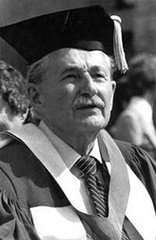12:00am: Anyone who has information on voter turnout in this election, please let me know.
11:20pm: One final thought: McFadyen got one thing right. In his concession speech he noted: "Manitobans were clearly not looking for change today." Can anyone recall an election that changed so little? Only three seats changed hands (Kirkfield Park and Southdale to the NDP, Brandon West to the Conservatives). Only one cabinet minister was ousted (Scott Smith). The popular vote swung about 2 percentage-points. I'm all ears if anyone remembers a similar event.
11:18pm: Some final thoughts:
*The NDP -- Merely maintaining the party's level of popularity is a huge credit to the Premier and his advisors. Tying Duff Roblin's (1966) modern record of 36 seats and a third straight majority is historic. Doing so while increasing its presence in the legislature following each campaign: unprecedented. Few parties in Canadian history have been able to sustain momentum over such a long period of time. Kudos where kudos is due. Some reasons for concern: First, the Premier will have some difficult decisions to make regarding cabinet positions. Only one minister was ousted, which leaves a lot of incumbents. Tim Sale's retirement and Scott Smith's loss will free up some room, but he's got a ton of new talent -- particularly suburban women -- to bring into the fold. He left a lot of people out of portfolios last time around, too, which means plenty of resumes will be on Doer's desk tomorrow morning. Second, while the NDP now finds itself with an unprecedented level of support inside the Perimeter, the party has lost its momentum in Southern rural ridings. The Yellowhead is even more blue than before, and the Tories have regained traction in Brandon. The rural-urban divide -- so evident in federal politics, and a hallmark in provincial politics -- is deeper than ever in Manitoba. Doer's replacement -- and "Tomorrow's NDP" -- will have to contend with this climate in the next campaign. Will the party extend another olive branch to rural Manitoba, or content itself with fortifying Fortress Winnipeg? My money's on the latter. The challenges ahead: breaking the rest of the Manitoba electoral records. Can the NDP tie Duff Roblin's 4 consecutive election victories (1958, 1959, 1962, 1966)? Can they become the first Manitoba party in history to win 4 consecutive majorities? One record that will have to wait: Duff is the only party leader to win 40% of the popular vote in four consecutive elections. (Doer would have to win two more landslides to equal that mark.) The fact that Today's NDP is competing against a Tory leader from over 4 decades ago should be disheartening to Today's PC's.
*The PCs -- A disappointment. No one expected McFadyen to win this election, but they expected him to better Stuart Murray's lackluster effort in 2003. He didn't. The Tories regained control of rural strongholds like Minnedosa and Russell, but lost almost everything in South Winnipeg. (Only McFadyen's Fort Whyte seat stood between Doer and a sweep of the region.) On the bright side, the PC party has only one direction to go: up. This is rock bottom for the party, and -- at over a third of the popular vote and seats -- it's still not all that bad. McFadyen needs more time to establish a rapport with the people, and to hone his political sense. (The Jets policy aside, he ran a fairly solid campaign.) The party looks to be on solid financial ground. What is more, the likelihood of the NDP holding on to South Winnipeg is very low. Doer cannot afford to put all of his new MLAs in Cabinet, and some of their seats will be prime for takeover next time around (Kirkfield Park, in particular). All of this said, the Conservatives have some soul-searching to do. McFadyen has two main challenges: (1) Balancing the desires of his rural base (his saviour), with his own need to break back into the urban ridings; and (2) Fending off Borotsik, who is certain to earn a prime position in the shadow cabinet, and the moral support of those in rural Manitoba. It's a long, uphill road ahead. But remember: No modern (post-1958)) Manitoba government has ever won 4 successive majorities.
*The Liberals: Just holding on to two seats ought to be a victory, but Gerrard and Lamoureux held out real hope for gaining official party status (4 seats). They'll have to settle for maintaining the status quo. It's unlikely Gerrard will stay on as leader in the next election. He's done well just to keep the party on the floor of the legislature. Lamoureux is an obvious contender to replace him, although the party may be well advised to seek a fresh face as his opponent. For now, the Liberals will have to content themselves with being the province's political conscience. As history tells us, only a charismatic leader (like Sharon Carstairs), or an upsurge in the Federal Liberals' fortunes, will provide the breakthrough the party needs.
*The Greens: At 0.38% of the popular vote, the party is dead. The Greens may blame the fact that they lacked the resources or volunteers to mount a credible campaign, but the real blame lies with the party membership, itself. Elect an undergraduate student as a party leader, and that's what you get. Not that there was much room on the left, to begin with.
10:28pm: Final results:
NDP -- 36 seats (+1) 47.7% vote (-1.8)
PC -- 19 seats (-1) 38.2% vote (+2.0)
LIB -- 2 seats (/) 12.41% vote (-0.8)
10:22pm: Some last-minute good news for the Tories. CBC predicts Mitchelson will hold on to the Tory seat in River East. With all polls reporting, she's won by 49 votes. Likely enough to withstand a mandatory recount. Better news for the party (but bad news for McFadyen): Borotsik wins Brandon West. With all polls reporting, he wins by 58 votes. Scott Smith is the only cabinet minister to lose his seat. The Tories lose only one seat: Kirkfield Park.
10:16pm -- Let's clarify the results: McFadyen will increase the Tories' share of the popular vote (from 36.7% to 38.23%), but lose between 3 and 5 seats. Why? Heading into the election, the Tories were actually leading in terms of the popular vote, prompting some to predict a possible "wrong-winner" outcome. Boy, were they wrong. While a dead-heat in the popular vote favors the NDP, the Tories actually lost votes during the campaign. The impetus for the decline: the Jets comment. Plain and simple. Manitobans have sent Hugh back to the Ledge to study up. He'll take the opportunity.
10:15pm -- Mitchelson is behind by 14 votes with 1 poll yet to report. We're looking at a recount, for sure.
10:13pm -- The electoral map has changed -- albeit subtly -- for the first time in 4 decades. The NDP has stolen South Winnipeg from the Tories, building on momentum from 1999 and 2003. The breakthrough is a sure sign that Doer's Third Way has won over the middle-class, Tim Horton's / soccer mom crowd. South Winnipeg is no longer the Tory bastion it once was. On the other hand, the more things change, the more they stay the same. The Tories have regained their feet in rural Manitoba, actually increasing their strength -- particularly along the Yellowhead highway. Russell and Minnedosa are back in the "solid-blue" category. Sadly for the Conservatives, this is their only area of strength.
10:08pm -- Let's talk women. Gary Doer will have big decisions to make -- and has a great opportunity to create gender parity in Cabinet. The suburbs are teeming with great MLAs, who just happen to be NDP women. Here are some top contenders:
*Theresa Oswald (Seine River) -- She has to be in the inner-circle; top contender for Doer's job once he steps down.
*Diane McGifford (Lord Roberts) -- She will be in Cabinet. The only question is: where?
*Erin Selby (Southdale) -- She stole Reimer's seat. If Doer wants to shore up his new suburban beach head in South Winnipeg, look for Selby to be given a junior portfolio.
*Kerri Irvin-Ross (Fort Garry) -- She was shuffled into cabinet last term, and won the seat handily this time around. Look for her to be shuffled out of Healthy Living in favor of Selby.
*Roseann Wowchuk (Swan River) -- Ag Minister. She's done a great job.
*Marilyn Brick (St. Norbert) -- Gotta be a minister.
*Nancy Allan (St. Vital) -- Her, too.
*Christine Melnick (Riel) -- A shoe-in.
*Bonnie Korzeniowski (St. James) -- Might get into Cabinet.
*Erna Braun (Rossmere) -- Longshot.
*Sharon Blady (Kirkfield Park) -- A longshot for Cabinet. Too inexperienced. The NDP may be willing to sacrifice this seat next time around, as the Tories will be sure to run a high profile challenger to win it back.
The Tories only have Myrna Driedger (Charleswood), Leann Rowatt (Minnedosa), Mavis Taillieux (Morris), and Heather Stefanson (Tuxedo) left. Mitchelson's on the bubble in River East.
9:50pm -- No cabinet minsters have lost yet. That's a telling statistic.
9:46pm -- Brandon West and River East are the only two seats left in play.
9:45pm -- Ron Lemieux holds on in La Verendrye. Tories are in big, big trouble.
9:42pm -- Oswald is elected in Seine River and Selby in Southdale. The NDP has quite the compliment of women -- perhaps even stronger than the Tories, now.
9:40pm -- Derkatch wins in a blowout in Russell. The Yellowhead is coated with blue.
9:39pm -- Bonnie Mitchelson's in trouble in River East. This would be a huge blow to the Tories, and break up their women's caucus.
9:37pm -- Isn't it somewhat ironic that the biggest Jets fans are in the rural areas? Maybe they should move the NHL team to Brandon or Portage?
9:36pm -- Faurschou holds onto Portage for the Tories. Another 500-vote victory, but they'll take any seat they can get.
9:34pm -- Minnedosa goes solidly Tory. Don't expect Doer to be paving any more highways or building any more libraries along the Yellowhead this term.
9:29pm -- Update on the seats the Tories targeted: Good news in Brandon West and La Verendrye... Borotsik and Stefaniuk are holding their own against Smith and Lemieux. Bad news in Riel, Assiniboia, and The Maples: The NDP won, and it wasn't even close.
9:23pm -- Caldwell holds Brandon East for the NDP, but Borotsik's giving Smith a run for his money in Brandon West. This one could be entertaining. If I'm McFadyen, I'm torn -- The Tories need the seat, but Borotsik is #1 in line for the leadership.
9:13pm -- Benchmarks to watch:
Doer's performance in 2003: 49.47% popular vote; 35 seats.
Biggest blowouts since 1958: 36 seats (Roblin PCs 1959, 1962); Doer's 49.47% in 2003.
Lowest turnout: 54.17% (2003)
9:05pm -- NDP holds on to Radisson.
9:o3pm -- Brick wins St. Norbert. Looks like an NDP sweep in the suburbs. Doer could actually increase his majority. It's the Jets comment (and low turnout).
9:03pm -- PC's pull ahead in La Verendrye. Lemieux looks like he could be vulnerable.
9:00pm -- Liberal vote looks very, very weak. This is a surprise. Perhaps the party is the biggest victim of voter apathy after the long weekend? Gerrard deserved better than 12%.
8:58pm -- Newsworld stops its coverage on TV. Discrimination!
8:57pm -- Conrad Santos loses. NDP keeps Wellington. Thank goodness: no more knives in the house chamber!
8:55pm -- Lamoureux wins in Inkster, and Gerrard in River Heights. Liberals hold their ground.
8:55pm -- Irvin-Ross wins in Fort Garry. Bad sign for the Tories in the suburbs.
8:54pm -- Blady wins Kirkfield Park. Stuart Murray must be secretly chuckling. Stefanson's old seat has gone Dipper. Wow. A bad sign for the Conservatives. They're now admitting they were out-campaigned. No kidding.
8:52pm -- Update on the swing seats... Tories ahead only in Minnedosa. NDP ahead everywhere else: St. Norbert, Southdale, La Verendrye, Radisson, Seine River, Rossmere, Brandon East.
8:49pm -- The night's not over yet. The overall outcome may be a foregone conclusion, but it will be interesting to see if Doer can make breakthroughs in the rural South. It looks like he might sweep the suburbs. Or, can McFadyen regain some momentum and set up a real rural-urban divide in the province?
8:46pm -- Things to watch in the coming weeks: Will Gerrard follow through on his promise to buy carbon offsets to pay for the Liberal campaign?
8:42pm -- CBC calls the election. That didn't take long. Doer with a third consecutive majority. Historic. Not even the Dippers expected a call this early. The convention hall is still empty. Doer's still out on his walk.
8:42pm -- Oooh... Those early Winnipeg numbers look bad for Tories. 55% and leading or elected in 26 of 30 seats for the NDP in the city.
8:41pm -- More on Coletto's hackery: No kidding, the campaign finance rule changes have impacted the outcome of this election. But how? Once the parties file their returns, we'll probably see the Tories raised more money than the NDP, and the Liberals did better than expected. That's from my interviews, anyway. By the way: Coletto's turned off his cell phone in order to avoid me.
8:38pm -- Paul Thomas is right (what else is new): The Tories need to win by 5 percentage-points in the provincial popular vote in order to win a majority. A reason for electoral reform?
8:34pm -- Ashton is elected. No surprise.
8:31pm -- Coletto's email is on CBC. Hack! Blatant plagiarism of a paper by David Stewart and myself. Sad, sad, sad. Shame, shame, shame.
8:28pm -- Paul Edwards is representing the Liberals on the CBC panel. Interesting.
8:26pm -- Uh oh, Tories... Very early Brandon West results have Scott Smith in the lead. Southdale: Selby leads Reimer. Both by fairly high margins. No surprise: Goertzen (Tory House Leader) wins Steinbach.
8:24pm -- Live from the Tory Headquarters. They're putting on a brave face. Brent Pooles is naming Brandon West, La Verendrye, Riel, Assiniboia, and The Maples as their targeted ridings.
8:20pm -- My list of ridings to watch: Rossmere, Brandon West, St. Norbert, Southdale, La Verendrye, Radisson, Fort Garry, Inkster, Seine River, River Heights, Wellington.
8:18pm -- Early quote of the night: "It would be very strange if Mr. Dyck didn't pull it out tonight."
8:14pm -- Minnedosa gets its first mention of the broadcast. Keep your eye on this riding... If the NDP doesn't finally breakthrough here, the party may give up on the constituency (and the Yellowhead region) next time around.
8:13pm -- Thank goodness Paul Thomas is providing commentary on CBC tonight. Can't imagine how the other "political scientists" would fare.





